
CATALOG
INDEX
THE SIMULTANEITY OF BREATHING
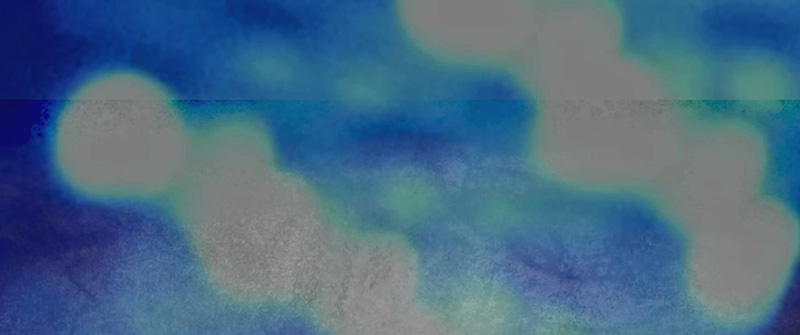
Short Synopsis: In "The Simultaneity of Breathing", Mersolis Schöne envisions experimental film production as a place of encounter where drawings and press photos by Austrian artist Lisa Est and Thomas Ballhausen's poetry come together in a shared philosophical experiment. Through the voices of Apollina Smaragd (German) and James Delaney (English), lines such as "words / that always keep us alive" lead us to the threshold of a semantic breath. The film itself takes shape as a living, poetic being that explores those fleeting moments when reality and possibility meet in the blur between breaths.
Short Synopsis (in German): In „Die Gleichzeitigkeit der Atmung“ begreift Mersolis Schöne die experimentelle Filmproduktion als einen Ort der Begegnung, an dem Zeichnungen und Pressefotos der österreichischen Künstlerin Lisa Est und Thomas Ballhausens Poesie in einem gemeinsamen philosophischen Experiment aufeinandertreffen. Durch die Stimmen von Apollina Smaragd (Deutsch) und James Delaney (Englisch) führen Zeilen wie „Worte / die uns stets lebendig halten“ in den Grenzbereich eines semantischen Atems. Der Film selbst nimmt Gestalt an als lebendiges, poetisches Wesen, das jene flüchtigen Momente ergründet, in denen sich Wirklichkeit und Möglichkeit in der Unschärfe zwischen den Atemzügen begegnen.
Title: The Simultaneity of Breathing
Original Title: Die Gleichzeitigkeit der Atmung
Completion Date: November, 2024
Country of Origin: Austria
Film, Direction, Editing: Mersolis Schöne
Based on Artworks by: Lisa Est
Text: Thomas Ballhausen
Voices: Apollina Smaragd and James Delaney
Sound Art and Composition: Caminauta
Sound Mix: Raul Tizze
Film Type: Artwork Film, Video Poem
Original Format: 4K, DCP
Running Time: 4:14 minutes
Producers: Mersolis Schöne and Lisa Est
Trailer:
Vimeo, Youtube
IMDb:
IMDb
Poster and Stills:
html,
folder,
Flickr,
and zip-file
"The Simultaneity of Breathing" © Copyright 2024 MOVING THOUGHT
REPEAT

Short Synopsis: "Repeat" is an experimental poetry film that brings together the poem "light from the greenery" by Austrian author Sigrun Höllrigl with Indian actress Savita Rani. In conjunction with the music and sound composition by Michael Fischer, as well as the voices of Christian Reiner and Apollina Smaragd, the film delves into the enigmatic world between déjà vu and jamais vu.
Short Synopsis (in German): „Repeat“ ist ein experimenteller Poesiefilm, der das Gedicht „licht ins grün“ der österreichischen Autorin Sigrun Höllrigl mit der indischen Schauspielerin Savita Rani zusammenbringt. In Verbindung mit der Musik und Klangkomposition von Michael Fischer sowie den Stimmen von Christian Reiner und Apollina Smaragd taucht der Film in die rätselhafte Welt zwischen Déjà-vu und Jamais-vu ein.
Title: Repeat
Completion Date: November, 2023
Country of Origin: Austria
A Film by Mersolis Schöne
Based on a Poem by Sigrun Höllrigl
Cast: Savita Rani
Concept: Sigrun Höllrigl, Mersolis Schöne
Voices: Christian Reiner, Apollina Smaragd
Music and Sound Composition: Michael Fischer
Camera and Editing: Mersolis Schöne
Translation: Mark Kanak
Film Type: Experimental, Video Poem
Original Format: 4K, DCP
Running Time: 5:55 minutes
Production Manager: Sigrun Höllrigl
In Co-Production with Moving Thought
Supported by: Stadt Wien, Kultur Niederösterreich, Federal Ministry Republic of Austria for Arts, Culture, Civil Service and Sport
Trailer:
Vimeo
IMDb:
IMDb
Poster and Stills:
html,
folder,
Flickr,
and zip-file
"Repeat" © Copyright 2023 MOVING THOUGHT
THE HISTORY OF PROXIMITY
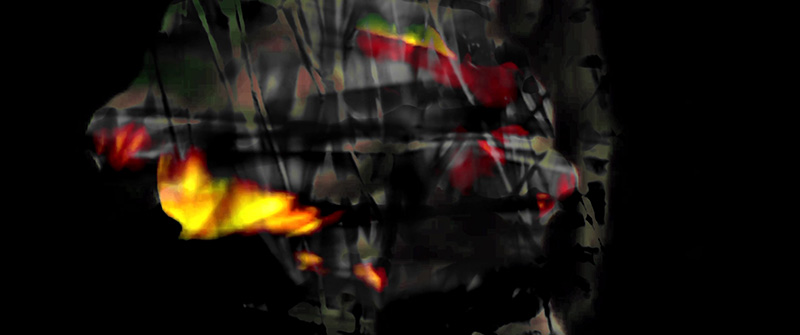
Short Synopsis: When two human bodies touch, a silent, unwritten "history of proximity" emerges – a dance through time, fleeting yet enduring. Based on drawings by artist Lisa Est and with the poetry by Herbert J. Wimmer, the film depicts touch as evidence of a shared history, as a tacit conversation between bodies that triggers a new history of commonality (Tactile Historiogenesis).
About the artist Lisa Est: Lisa Est, born in Wr. Neustadt Lower Austria, has lived in Vienna since 1972. In her works - drawings, collages, prints, objects, and animated films - she focuses on the “Menscheln," or the human identities, clichés, and role models. The media and newspapers provide the material for this art with daily headlines, which Lisa Est - detached from their original context - then assembles into collages and other mediums. Language and time merge in objects, assemblages, and installations - all made from newsprint (often crocheted) - to form spatial interactions. "PalimpsEst" is based on these cycles of works. Lisa Est is a member of the artP Kunstverein, Galerie Blaugelbezwettl, and IntAkt (Internationale Aktionsgemeinschaft bildender Künstlerinnen).
Short Synopsis (in German): Berühren sich zwei menschliche Körper, dann zeichnet sich eine stille, ungeschriebene "Historie der Nähe" ab – ein Tanz in der Zeit, flüchtig und doch beständig. Basierend auf Zeichnungen der Künstlerin Lisa Est und mit der Poesie von Herbert J. Wimmer, versteht der Film Berührungen als Zeugnisse einer geteilten Geschichte, als stillschweigende Konversation zwischen Körpern, die eine neue Historie der Gemeinsamkeit auslösen (Taktile Historiogenese).
About the artist Lisa Est (in German): Lisa Est, geboren in Wr.Neustadt NÖ, lebt seit 1972 in Wien. In ihren Arbeiten - Zeichnungen, Collagen, Druckgrafiken, Objekten und Animationsfilmen - thematisiert sie den Menschen, das „Menscheln“, Identitäten, Klischees und Rollenbilder. Material dazu liefern Medien und Zeitungen mit täglichen Schlagzeilen, die Lisa Est - losgelöst aus ihrem ursprünglichen Kontext - in ihre Arbeiten collagiert oder zu Texten montiert. Sprache und Zeit verschmelzen in Objekten, Assemblagen und Installationen - hergestellt aus Zeitungspapier (oft gehäkelt) - zu räumlichen Interaktionen. „PalimpsEst“ basiert auf diesen Werkzyklen. Lisa Est ist Mitglied des artP Kunstvereins, der Galerie Blaugelbezwettl und der IntAkt (Internationale Aktionsgemeinschaft bildender Künstlerinnen).
Title: The History of Proximity
Original Title: Die Historie der Nähe
Completion Date: November, 2023
Country of Origin: Austria
Film, Direction, Editing: Mersolis Schöne
Based on Artworks by: Lisa Est
Texts: Herbert J. Wimmer
Voice and Text Arrangement: Apollina Smaragd
Sound Art and Composition: Caminauta
Sound Mix: Raul Tizze
Film Type: Artwork Film, Video Poem
Original Format: 4K, DCP
Running Time: 99 seconds
Producer: Mersolis Schöne and Lisa Est
Trailer:
Vimeo
IMDb:
IMDb
Poster and Stills:
html,
folder,
Flickr,
and zip-file
"The History of Proximity" © Copyright 2023 MOVING THOUGHT
SIGN ACTION SPACE
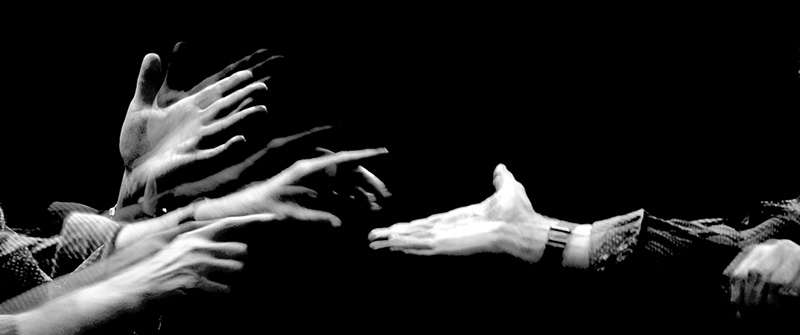
Short Synopsis: "Sign Action Space" is a short experimental film about the musical actions of the hands of the Vienna Improvisers Orchestra. Led by Michael Fischer, who conducts the orchestra on an ad hoc basis using a vocabulary of hand signs, the orchestra creates unique compositions in the moment. The film explores the relationship between musical hand movements, sound, and space, deconstructing and condensing the orchestral communication process in graphic close-ups that focus on the hands of the conductor and the musicians. Using 14 cameras and various layering, animation, and stylization methods, the film aims to delve into the fascinating world of the ephemeral communication process that results in the creation of momentary compositions.
Synopsis: The Vienna Improvisers Orchestra is one of the first and continuously working improvisation orchestras in Europe. The ensemble creates unique musical textures through free improvisation, shaped in the moment by its ad hoc conductor and founder Michael Fischer, who communicates with the musicians through a vocabulary of hand signs for dynamics, pitch, tempo, duration, and more. "Sign Action Space" follows the genesis of sound in this context of experimental composition and complex improvised music. The short film takes a concert performance as its starting point and explores the relationship between musical hand movements, sound, and space. Through graphic close-ups, mainly in black and white with rich contrasts, the film deconstructs and separates the orchestral communication process, layering and compressing it before bringing it back together in movements to rhythm and melody. After introducing a selection of hand signs used by the conductor to communicate with the musicians, the film turns to the dynamics of the orchestra in space. The viewer is led into the fascinating world of musical hand movements, where the orchestra's music emerges in the moment. The film deals with the perception of this ephemeral communication and its rhythmic dynamics related to the hands and instruments. Using 14 cameras and various layering, animation, and stylization methods, the film experimentally processes a sequence of the Vienna Improvisers Orchestra's instant composition praxis in a super wide-screen format.
Ensemble: Isabell Kargl - voice, Sun Sun Yap - voice, Nika Zach - voice, Tahereh Nourani - flute, Elisabeth Kelvin - clarinet, bass clarinet, Lisa Hofmaninger - soprano saxophone, bass clarinet, Clemens Salesny - alto saxophone, bass clarinet, Florian Sighartner - violin, Emily Stewart - violin, Judith Reiter - viola, Irmi Wolvin - cello, Clemens Sainitzer - cello, Beate Wiesinger - double bass, Edward Reardon - synthesizer, Valentin Duit - drums, and instant composition conducting by Michael Fischer
Sign Action Space – notes by Dr Joshua Bergamin
Gesture follows gesture. Action follows sign. In free improvisation, every sonic gesture is both a response and an invitation to respond. Without a score to guide them, improvisors create by attending to what the moment calls for – by acting, and then refining and reacting to those actions in real time. For 20 years now, the Vienna Improvisor’s Orchestra has been creating together, with 14 to 18 musicians making music as responses to Michael Fischer’s ‘real time compositions.’ While adopting the role of a conductor, Fischer can likewise only respond to what each moment offers. The musical results take on a life of their own, unfolding in the space between conductor, musician, and instrument.
The Orchestra’s music – like all improvised music – is never reducible to the decisions of any individual performer. And in fact – since responding in the real-time flow is more re-action than action – such music calls into question the very concepts of ‘decision’ and ‘agency’ in creativity, forcing us to ask who decides, who creates?
Sign Action Space brings these questions to the foreground, documenting a live performance of the VIO while simultaneously de-centring the human subjects. As the music unfolds, our attention is drawn to the intimate gestures of the performers – to bodies in space that both respond to and create the music. The camera’s shifting focus meditates on repetitions and changes – both subtle and dramatic – that collectively shape a music that is more than the sum of its parts.
The juxtaposition between visual fragments – rendered silhouette-like in black-and-white – with the dynamic sonic flow of the Orchestra’s improvisation, maintain a constant tension and sense of dislocation for the viewer. As for an improvising musician themselves, the music seems to come from everywhere and from nowhere – and from right here,now here.
Sign Action Space is thus a wordless voyage into the heart of a more primordial communication, an immersion into the gathering of humans, instruments, and spaces that bring each other to life as a new collectivity.
Title: Sign Action Space
Completion Date: January, 2023
Country of Origin: Austria
Film Type: Experimentell, Short
Film, Concept, Direction, Editing: Mersolis Schöne
Featuring: Vienna Improvisers Orchestra
Instant Composition Conducting: Michael Fischer
Camera: Alexander Bachmayer, Andreas Reisenbauer, Mersolis Schöne, Patrick Seidl, Christan Venosa
Sound Editing: Paul Gründorfer and Michael Fischer
Consulting and Assistance: Andreas Reisenbauer
Make-Up, Costume Advice: Sabine Koch
Original Format: 4K, DCP
Running Time: 12 minutes
Producer: Mersolis Schöne
Supported by: Federal Ministry Republic of Austria for Arts, Culture, Civil Service and Sport
Trailer:
Vimeo
IMDb:
IMDb
Poster and Stills:
html,
folder,
Flickr,
and zip-file
"Sign Action Space" © Copyright 2023 MOVING THOUGHT
PALIMPSEST
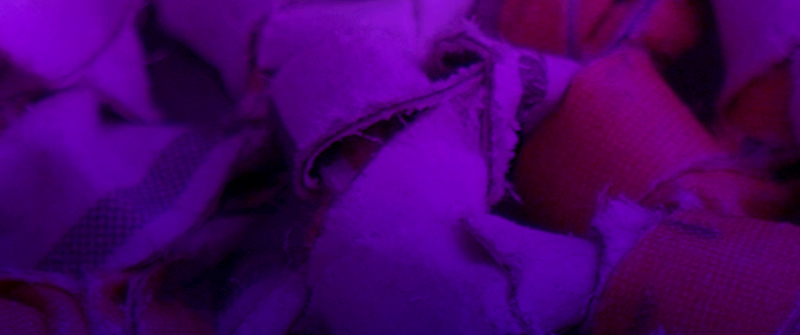
Synopsis: A decade in newspaper headlines - Austrian artist Lisa Est has cut out, torn, and collected these headlines. She has crocheted, glued, wrapped, and randomly mixed them together, creating a multi-layered work between object and collage art as well as experimental literature. "PalimpsEst" scratches, illuminates, and recombines these layers of transformation into 9 experimental image-and-sound poems:
About the artist Lisa Est: Lisa Est, born in Wr. Neustadt Lower Austria, has lived in Vienna since 1972. In her works - drawings, collages, prints, objects, and animated films - she focuses on the “Menscheln," or the human identities, clichés, and role models. The media and newspapers provide the material for this art with daily headlines, which Lisa Est - detached from their original context - then assembles into collages and other mediums. Language and time merge in objects, assemblages, and installations - all made from newsprint (often crocheted) - to form spatial interactions. "PalimpsEst" is based on these cycles of works. Lisa Est is a member of the artP Kunstverein, Galerie Blaugelbezwettl, and IntAkt (Internationale Aktionsgemeinschaft bildender Künstlerinnen).
Quote from a review 1: The film "PalimpsEst" by Mersolis Schöne, highlighting the artistic works of Lisa Est, is layered in every sense of the word - it reveals overlays of all kinds: sound, tone, image, writing, alternating between black-and-white and color segments. As is inherent to palimpsests, contents rise from the deeper layers to the surface, merging with their meanings. The various layers intertwine seamlessly. What do we witness? Textual fabrics, sequences of symbols, threads of signs, artfully woven by Lisa Est, representing a language that's literally tangled. Over this, the camera glides, creating both clarity and obscurity. In line with the three-dimensionality of Lisa Est's text objects, the film presents alternating spatial situations in continuous motion, a consistent sinking and re-emergence to the surface, a hovering between layers. Characters transform into visual elements, with rhythmic fluctuations in fields of meaning becoming evident. Wolfgang Seierl's soundtrack adeptly captures the sound of scraping on parchments and the whispers of texts intermingling with one another. "PalimpsEst" is a distinctive cinematic artwork that delightfully transforms an already multi-layered piece of art into film art - - it invites you to poetic amazement.
HERBERT J. WIMMER & MARION STEINFELLNER
Synopsis in German: Ein Jahrzehnt in Zeitungsschlagzeilen – die österreichische Künstlerin Lisa Est hat diese Schlagzeilen ausgeschnitten, herausgerissen und gesammelt. Sie hat diese gehäkelt, aufgeklebt, gewickelt, zufällig zusammengemischt und daraus ein vielschichtiges Werk zwischen Objekt- und Collagekunst sowie experimenteller Literatur geschaffen. “PalimpsEst“ bekratzt, durchleuchtet und rekombiniert diese Schichten der Transformation in 9 experimentellen Bild- und Klanggedichten:
About the artist Lisa Est (in German): Lisa Est, geboren in Wr.Neustadt NÖ, lebt seit 1972 in Wien. In ihren Arbeiten - Zeichnungen, Collagen, Druckgrafiken, Objekten und Animationsfilmen - thematisiert sie den Menschen, das „Menscheln“, Identitäten, Klischees und Rollenbilder. Material dazu liefern Medien und Zeitungen mit täglichen Schlagzeilen, die Lisa Est - losgelöst aus ihrem ursprünglichen Kontext - in ihre Arbeiten collagiert oder zu Texten montiert. Sprache und Zeit verschmelzen in Objekten, Assemblagen und Installationen - hergestellt aus Zeitungspapier (oft gehäkelt) - zu räumlichen Interaktionen. „PalimpsEst“ basiert auf diesen Werkzyklen. Lisa Est ist Mitglied des artP Kunstvereins, der Galerie Blaugelbezwettl und der IntAkt (Internationale Aktionsgemeinschaft bildender Künstlerinnen).
Quote from a review 1 (in German): Der Film „PalimpsEst“ von Mersolis Schöne zu künstlerischen Arbeiten von Lisa Est ist in jeder Bedeutung des Wortes vielschichtig – es zeigen sich Überlagerungen aller Art: Sound Klang Bild Schrift, Wechsel von Schwarzweiß- und Farbpassagen. Wie es Palimpsesten eigen ist, steigen aus tieferen Schichten Inhalte an die Oberflächen und vermischen sich mit deren Bedeutungen. Die verschiedenen Layers lagern sich ineinander ein. Was sehen wir? Textgewebe, Zeichenketten, Zeichenfäden, kunstvoll von Lisa Est verwebt, buchstäblich verstrickte Sprache, über die die Kamera schwenkt, Schärfe und Unschärfe produzierend. Entsprechend der Dreidimensionalität von Lisa Ests Textobjekten zeigt der Film abwechselnde Raumsituationen in kontinuierlicher Bewegung, ein stetes Absinken und wieder an die Oberfläche steigen, ein Schweben zwischen den Schichten. Schriftzeichen werden Bildelemente, rhythmisierte Schwankungen in Bedeutungsfeldern treten auf. Der Soundtrack von Wolfgang Seierl gibt das Geräusch des Schabens an Pergamenten und das Flüstern der Texte ineinander und miteinander kongenial wieder. PalimpsEst ist ein eigenwilliges Filmkunstwerk, das auf beglückende Weise ein an sich schon aus vielen Schichten bestehendes piece of art in Filmkunst verwandelt - es lädt zum poetischen Staunen ein.
HERBERT J. WIMMER & MARION STEINFELLNER
Title: PalimpsEst
Completion Date: October, 2022
Country of Origin/Filming: Austria/Austria
Project Type: Experimentell, Short
Film Type: Artwork Film, Video Poem
Film, Concept, Direction, Editing: Mersolis Schöne
Based on Artworks by: Lisa Est
Sound and Composition: Wolfgang Seierl
Original Format: 4K, DCP
Running Time: 9 minutes
Producer: Mersolis Schöne
Trailer:
Vimeo
Poster and Stills:
Flickr, html,
folder, and
zip-file
IMDb:
IMDb
"PalimpsEst" © Copyright 2022 MOVING THOUGHT
EXPOSED TO EACH OTHER
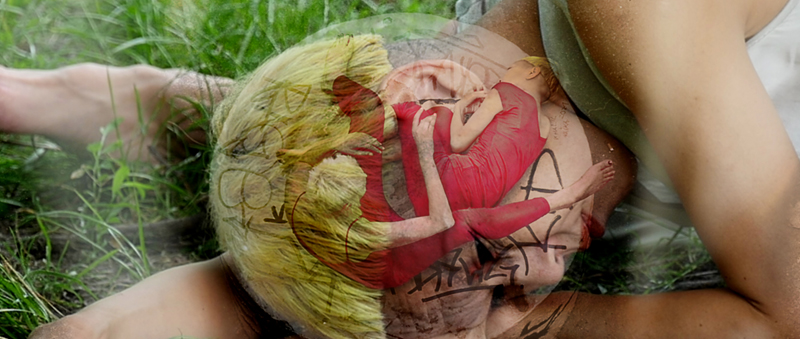
Synopsis: Touches are journeys - a film poem about the multi-faceted journey of interpersonal, intercultural encounters. How are we connected with each other? Based on a poetic text collage by Marion Steinfellner, which brings together Indian, Japanese, German, and Austrian texts by Yuko Kaseki, Savita Rani, Mersolis Schöne, and Marion Steinfellner.
Synopsis in German: Berührungen sind Reisen – ein Filmgedicht über die facettenreiche Reise der zwischenmenschlichen, interkulturellen Begegnung. Wie sind wir miteinander verbunden? Basierend auf einer poetischen Textcollage von Marion Steinfellner, die indische, japanische, deutsche und österreichische Texte von Yuko Kaseki, Savita Rani, Mersolis Schöne und Marion Steinfellner zusammenführt.
Background: In an exchange between artists from Austria, Japan, India, Ukraine, and Germany, literary, performative, sonic, and cinematic questions will be asked: How are we connected to each other? How do these connections change? How do we generate connections in a solidary, inspiring, and sustainable way? Through the encounters in the collaboration with the participating artists, texts were written that Marion Steinfellner processed into a text collage. On this basis, experimental film scenes with performance and Butoh dance elements were created. In addition, a print-ready version of the text collage was made. The intercultural exchange leads to hybrid and interactive text-performance-sound-film forms, which can each stand alone, but can also be placed in relation to each other again and again, with the question: How are we connected to each other?
Background in German: Im Austausch zwischen Künstler:innen aus Österreich, Japan, Indien, der Ukraine und Deutschland wird literarisch, performativ, klanglich und filmisch gefragt: Wie sind wir miteinander verbunden? Wie verändern sich diese Verbindungen? Wie generieren wir Verbindungen in einer solidarischen, inspirierenden und nachhaltigen Art und Weise? Durch die Begegnungen in der Zusammenarbeit mit den beteiligten Künstler:innen wurden Texte verfasst, die Marion Steinfellner zu einer Textcollage verarbeitete. Auf dieser Basis entstanden experimentelle Filmszenen mit Performance- und Butohtanz-Elementen. Zudem wurde eine druckreife Fassung der Textcollage erstellt. Der interkulturelle Austausch mündet in hybriden und interaktiven Text-Performance-Klang-Film-Formen, die jeweils für sich allein stehen können, ebenso jedoch immer wieder neu in Beziehung gesetzt werden, mit der Fragestellung: Wie sind wir miteinander verbunden?
Quote from a review 1: Poetry becomes concrete in the densely composed now of the film, in the moments of its realization in the consciousness of the viewer. In the now of the different ways of experiencing, in the now of poetry, the unique diversity of EXPOSED TO EACH OTHER comes into existence.
HERBERT J. WIMMER
Quote from a review 2: EXPOSED TO EACH OTHER is an unpredictable film, a film that challenges you, that stands apart from all genres because it pulls from all of them. It is a true synthesis of poetry and film that generates its own associations, connotations and metaphors that neither the original text nor the film by itself would have been able to provide. It is a movie that requires attention because you need to be drawn into the very special atmosphere created by all of the artistic elements working in sync. It is a piece of art, a piece of spoken word poetry, a dance film, an avant-garde experimental short, a collage. It is a movie that requires attention because the way it is made demands attention and thought. THE NEW JERSEY STAGE MAGAZIN
Title: Exposed To Each Other
Original Title: Einander Ausgesetzt
Completion Date: February, 2022
Country of Origin/Filming: Austria/Austria, India, Germany
Film Type: Video Poem, Experimental, Short, Plurifilm
Film, Concept, Direction, Editing: Mersolis Schöne
Text-Collage: Marion Steinfellner
Text: Savita Rani, Yuko Kaseki, Mersolis Schöne, Marion Steinfellner
Cast: Savita Rani, Yuko Kaseki, Marion Steinfellner
Sound and Composition: Michael Fischer
Beat and Flute Arrangement: Vlad Krypak
Flute Improvisation: Apollina Smaragd
Film Language: German and English
Original Format: 4K, DCP
Running Time: 13 minutes
Producer: Mersolis Schöne
Supported by and Special Thanks: Kulturforum New Delhi and Austrian Embassy New Delhi
Trailer:
Vimeo
Poster and Stills:
Flickr, html,
folder, and
zip-file
IMDb:
IMDb
"Exposed To Each Other" © Copyright 2022 MOVING THOUGHT
KATHARINA KLEMENT - NOTES, SOUND, AND FILM
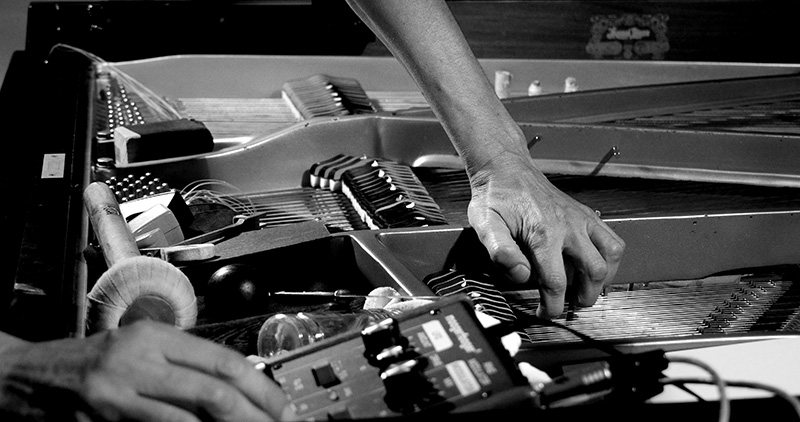
Synopsis: Vienna-based composer, pianist, and improviser Katharina Klement works on the expansion of the concept of music. She performs with piano and extended playing techniques on stages from Rudolfsheim-Fünfhaus to New York City. "Katharina Klement – Notes, Sound, and Film" takes us behind the scenes and gives an insight into the genesis environment and the creative process of her work. With Mersolis Schöne, the artist talks about the process of creating the joint film work "Love – A Memory Sculpture". Based on observations, interviews, performative elements, and readings, the film resonates with her in an experimental way as it traces the artists working process.
Synopsis in German: Die in Wien lebende Komponistin, Pianistin und Improvisatorin Katharina Klement arbeitet an der Erweiterung des Musikalischen. Sie konzertiert mit Klavier und erweiterten Spieltechniken auf Bühnen von Rudolfsheim-Fünfhaus bis New York City. "Katharina Klement – Noten, Klang und Film" entführt uns hinter die Kulissen und gibt einen Einblick in die Entstehungsumgebung und den kreativen Prozess zu ihrem Werk. Mit Mersolis Schöne bespricht die Künstlerin den Entstehungsprozess zum gemeinsamen Filmwerk "Liebe – Eine Gedächtnisskulptur". Anhand von Beobachtungen, Interviews, performativen Elementen und Lesungen zeichnet der Film den Arbeitsprozess der Künstlerin nach und geht in experimenteller Weise mit ihr in Resonanz.
Title: Katharina Klement – Notes, Sound, and Film
Original Title: Katharina Klement – Noten, Klang und Film
Completion Date: December, 2021
Country of Origin: Austria
Film Type: Documentary, Short
Film, Concept, Direction, Editing: Mersolis Schöne
Interview and Script: Mersolis Schöne
Text read in the film: Katharina Klement
Cast: Katharina Klement
Sound and Composition: Katharina Klement
Film Language: German and English
Original Format: 4K
Running Time: 15 minutes
Producer: Mersolis Schöne
Full Film:
Vimeo
Stills:
html,
folder, Flickr, and
zip-file
"Katharina Klement – Notes, Sound, and Film" © Copyright 2021 MOVING THOUGHT
IN THIS PRESENT SPACE
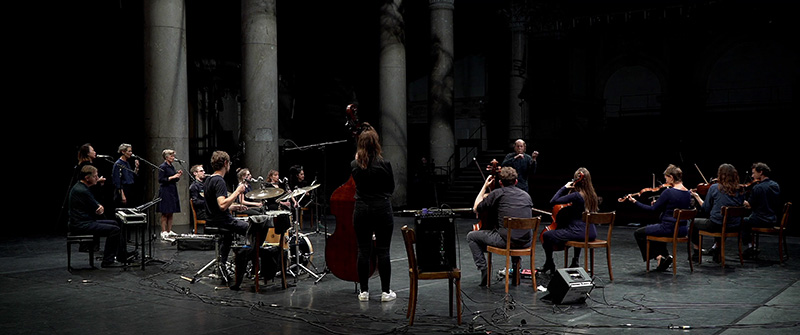
Synopsis: An introspective journey through the ephemeral and unique nature of musical creation, "In This Present Space" showcases an exclusive concert performance by the Vienna Improvisers Orchestra (VIO) at Vienna's Odeon Theater, conducted by Michael Fischer. This film serves as a profound exploration of time, presence, and the fleeting artistry of performance, uniquely emphasizing the art of Instant Composition Conducting, a VIO hallmark technique where spontaneous musical ideas are relayed through hand signs, capturing the poetry of the moment.
Ensemble: Isabell Kargl - voice, Sun Sun Yap - voice, Nika Zach - voice, Tahereh Nourani - flute, Elisabeth Kelvin - clarinet, bass clarinet, Lisa Hofmaninger - soprano saxophone, bass clarinet, Clemens Salesny - alto saxophone, bass clarinet, Florian Sighartner - violin, Emily Stewart - violin, Judith Reiter - viola, Irmi Wolvin - cello, Clemens Sainitzer - cello, Beate Wiesinger - double bass, Edward Reardon - synthesizer, Valentin Duit - drums, and instant composition conducting by Michael Fischer
From the film: In the dramatic evidence of sounds one can find new space and meaning—from moment to moment. The sound worlds of the Vienna Improvisers Orchestra (VIO) emerge solely in the moment—sound architectures mediated by hand signals, designed together ad hoc. Since 2004, as one of the first improvisation orchestras in Europe, the ensemble has continuously developed a specific form of complex improvised music and experimental composition—and thus taking up an international discourse on newer concepts of sound organization for large ensembles. Hand signs—for example for dynamics, tempo or pitch—structure ad hoc texture and form of the music developed exclusively in the polylogue moment. Not only with its radical ad hoc practice does the VIO expose itself to uncertain terrain. The orchestra also appears with a line-up that changes from concert to concert and as well involves one or more new musicians each time. In poetic spaces, a jointly created, meaning-creating world opens up, whose becoming forever eludes revisiting—almost... (A text by Michael Fischer, spoken in the film by Anne Bennent)
Title: In This Present Space
Original Title: Partitur im Jetzt
Completion Date: December, 2021
Country of Origin: Austria
Film Type: Concert
Film, Concept, Direction, Editing: Mersolis Schöne
Director of Photography: Alexander Bachmayer
Camera: Christan Venosa, Patrick Seidl
Voice: Anne Bennent
Text: Michael Fischer
Consulting and Assistance: Andreas Reisenbauer
Make-Up, Costume Advice: Sabine Koch
Film Language: German
Subtitles: English
Original Format: 4K, DCP
Running Time: 57 minutes
Producer: Mersolis Schöne
Special Thanks: Max Kaufmann, Anne Bennent
Supported by: Federal Ministry Republic of Austria for Arts, Culture, Civil Service and Sport
Full Film:
Vimeo
IMDb:
IMDb
Poster and Stills:
html,
folder, Flickr, and
zip-file
Set Photography:
html,
folder, and
zip-file
"In This Present Space" © Copyright 2021 MOVING THOUGHT
THE REMEMBERING MOVEMENT
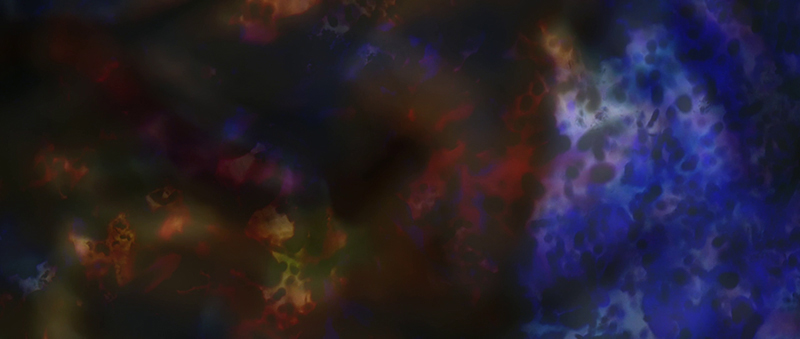
Synopsis: What is the silent moment between thoughts, glances, and memories? "The Remembering Movement" thinks poetically about this moment. This film depicts an experimental and poetic film triptych: "Thinking-Chant", "Gaze-Frame", and "Light-Texture" based on the painting/assemblage "Poetikweltlichter" by Marion Steinfellner and the poem "Since Then" by Marion Steinfellner and Mersolis Schöne. This is connected by Michael Fischer's soundscaping, which combines poetry and sound into a rhizomatic audio fabric triptych.
Synopsis in German: Was ist der stille Moment zwischen den Gedanken, Augenblicken und Erinnerungen? „Die erinnernde Bewegung“ denkt poetisch über diesen Moment nach. Ein experimentell-poetisches Filmtriptychon: „Denk-Gesang“, „Blick-Grenze“ und „Licht-Gewebe“ auf Grundlage der Gemäldeassemblage "Poetikweltlichter" von Marion Steinfellner und des Gedichtes „Inzwischen“ von Marion Steinfellner und Mersolis Schöne. Verbunden durch Michael Fischers Soundscaping, das Poesie und Klang zu einem rhizomatischen Klanggewebe-Triptychon verwebt.
Quote from a review: A film of extraordinary beauty, whose magic lies in showing, with all available film-aesthetic means, memory
as movement - and this one single neuronal moment, when perception becomes memory and memory becomes
perception. Every movement becomes memory, every memory becomes movement. The film is the river in which we
do not enter only once, which we experience, explore always anew and always in a new way. "The
Remembering Movement" flows through us as we follow its course, in the pull of the arrow of time, in
the interplay of flexible horizons of rhythms of depths of field and depths of focus, linguistic, verbal,
musical, pictorial. HERBERT J. WIMMER
Quote from a review in German: ein film von ausserordentlicher schönheit, dessen zauber darin liegt, mit allen zur verfügung stehenden filmästhetischen mitteln, gedächtnis als bewegung zu zeigen - und diesen einen einzigen neuronalen moment, wenn wahrnehmung zu erinnerung und erinnerung zu wahrnehmung wird. aus jeder bewegung wird erinnerung, aus jeder erinnerung entsteht bewegung. der film ist der fluss, in dem wir nicht einmal ein mal einsteigen, den wir stets neu und stets auf neue weise erfahren, erkunden. "Die erinnernde Bewegung" durchfliesst uns wie wir ihrem lauf folgen, im sog des zeitpfeils, im wechselspiel flexibler horizonte aus rhythmen von schärfentiefen und tiefenschärfen, sprachlich, sprechlich, musikalisch, bildlich. HERBERT J. WIMMER
Title: The Remembering Movement
Original Title: Die erinnernde Bewegung
Completion Date: July, 2020
Country of Origin/Filming: Austria
Film, Direction, Skript, Poem, Voice: Mersolis Schöne
Painting, Poems, Voice: Marion Steinfellner
Sound and Composition: Michael Fischer
Film Type: Video Art, Experimental, Short, Film Triptych
Film Language: German and English
Original Format: 4K, DCP
Running Time: 8 minutes 45 seconds
Producer: Mersolis Schöne
Trailer:
Vimeo
Poster and Stills:
Flickr,
html,
folder, and
zip-file
Interview with Marion Steinfellner:
Vimeo, Flickr,
html, and folder
IMDb:
IMDb
"The Remembering Movement" © Copyright 2020 MOVING THOUGHT
LOVE - A MEMORY SCULPTURE
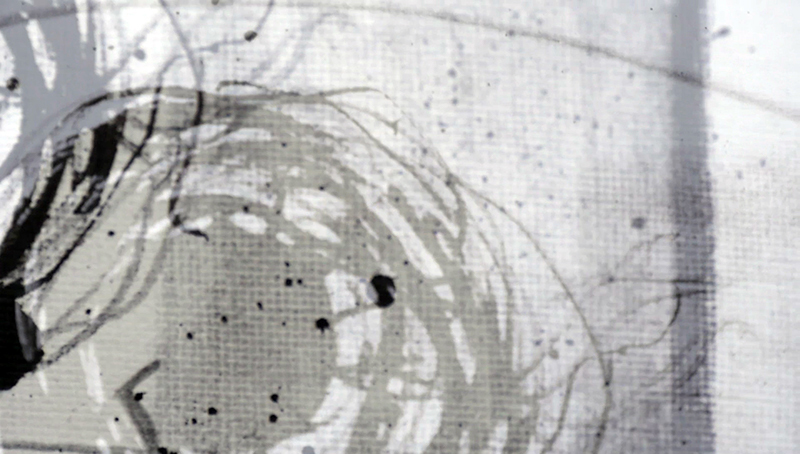
Synopsis: Sketches of an architecture of sculptural memory: abstract traces and noisy audible tissue; fuzzy symbols of dreams; overlapping spheres of dialogues; jumping details of resistance; fluid moments of realignment; vibrant togetherness of clarity; sounds grow more compressed and freeze; fragmented language. The film summarizes the results of an artistic-philosophical experiment in India - on the subject of love.
Synopsis in German: Entwürfe einer Architektur des skulpturalen Gedächtnisses: Abstrakte Spuren, geräuschvolles Gewebe; unscharfe Traumsymbole; überlagernde dialogische Sphären; springende Details des Widerstands; fließende Momente der Neuausrichtung; pulsierende Zusammengehörigkeit der Klarheit; verdichtete und erstarrte Klänge; fragmentierte Sprache. Der Film fasst die Ergebnisse eines künstlerisch-philosophischen Experiments in Indien zusammen - zum Thema Liebe.
Background: "Love - A Memory Sculpture" is a film-based philosophical research project which was created during an arts-based-philosophy residency in south India, provided by baseCollective (led by Susanne Valerie Granzer and Arno Böhler).
As a result of a 3 month residency at the Adishakti Center for Arts Research the film was part of the field performance "LOVE MATTERS... in which a transdisciplinary group of artists and philosophers from India and Europe research love on stage. They struggle together to de-construct stereotypical patterns of love for the sake of a multi-perspective view on an ambivalent phenomenon that touches us all." (performance announcement.)
After leaving India the pianist and composer Katharina Klement, the art historian and the voice of the film Apollina Smaragd, along with Mersolis Schöne who developed the film concept and drawings worked on the film further. This was done while following the residences concept of a multi-perspective view on love. In this context - keeping in mind that i.e. Alain Badiou thought about film as a "philosophical experiment" - the team followed the impulse while working on the concepts of love in which film is a medium of philosophy.
"Love - A Memory Sculpture" as a stand-alone experimental short film is the result of this intense intercultural and transdiciplinary process related to the topic of love.
Title: Love - A Memory Sculpture
Original Title: Liebe - Eine Gedächtnisskulptur
Completion Date: August, 2019
Country of Origin/Filming: Austria/India
Film and Drawings: Mersolis Schöne
Sound and Composition: Katharina Klement
Voice: Apollina Smaragd
Film Type: Video Art, Experimental, Short
Film Language: English
Original Format: 4K, DCP
Running Time: 3 minutes 52 seconds
Special Thanks: baseCollective
Producer: Mersolis Schöne
Trailer:
Vimeo
Poster and Stills:
Flickr,
html,
folder, and
zip-file
IMDb:
IMDb
Interview with Katharina Klement:
Vimeo
"Love - A Memory Sculpture" © Copyright 2019 MOVING THOUGHT
FOREVER
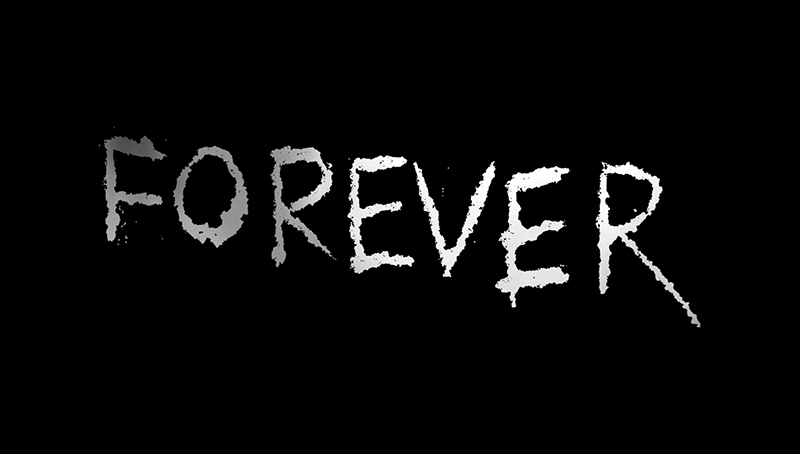
Synopsis: As an archive in constant change, walls surround us. As on skin, traces of urban life are shown on them. Out of the corners of our eyes, scratches, nicks, shapes, letters and words are absorbed by us in passing moments. This is an attempt to escape the temporal dimension of our being - "Friends Forever" - and anchor in the exuberance of feelings - "Love". They reveal our longing for continuity, visibility and the expression of becoming. The past is reflected in these skins of the city. Today’s manifestations of eternity will be nothing more than tomorrow’s background for future messages: constant change and eternity at the same time - being preserved in change.
The shooting was made in 2019 in Thanjavur, a city in the southern Indian state of Tamil Nadu.
Synopsis in German: Als Archiv im ständigen Wandel umgeben uns Wände. Wie auf einer Haut zeichnen sich auf ihnen Spuren des städtischen Lebens ab. Sie prägen Augenblicke im Vorbeigehen: Kratzer, Kerben, Formen, Buchstaben, Worte. Versuche, der zeitlichen Dimension unseres Seins zu entkommen - "Friends Forever" - und im Überschwang der Gefühle einen Anker zu setzen - "Love". Sie geben unsere Sehnsüchte nach Kontinuität, Sichtbarkeit und nach dem Ausdruck des Werdens preis. Die Vergangenheit zeichnet sich auf diesen Häuten der Stadt ab. Was sich heute dort für die Ewigkeit als Botschaft manifestiert, ist morgen der Hintergrund zukünftiger Botschaften: Ständige Änderung und Ewigkeit zugleich - Bewahren im Wandel.
Die Aufnahmen wurden 2019 in Thanjavur, einer Stadt im südindischen Bundesstaat Tamil Nadu, angefertigt.
Title: Forever
Completion Date: April, 2019
Country of Origin: Austria
Country of Filming: India
Direction: Mersolis Schöne
Film Type: Video Art, Documentary, Experimental, Short
Film Language: English
Original Format: 4K, DCP
Running Time: 25 seconds
Special Thanks: baseCollective
Producer: Mersolis Schöne
Trailer:
Vimeo
Poster and Stills:
Flickr,
html,
folder, and
zip-file
IMDb: IMDb
"Forever" © Copyright 2019 MOVING THOUGHT
DETERNITY

Short Synopsis: "Hey you! Watch out! What does the deep midnight say?" "Deternity" is an experimental poetic short film exploring Friedrich Nietzsche's poem "Once More" (also called "The Drunken Song" from the book "Thus Spoke Zarathustra"). By using a combination of performance and projection techniques, the film depicts a protagonist being confronted with his own psychological dilemmas in a scene dominated by alternating light and shadows.
Synopsis: "Hey you! Watch out! What does the deep midnight say?" – "Deternity" is an experimental short film exploring Friedrich Nietzsche's famous poem "Once More" (also known as "The Drunken Song" from the book "Thus Spoke Zarathustra"). Performative staging and projection techniques are combined based on a specially designed new English translation for the film. A setting is created that shows a protagonist confronted with his psychic dilemmas, alternating between light and shadow. "Deternity" has been described as a "tense, thought-provoking, and strangely symphonic experimental feat" (Ouchy Film Awards). The film has gained attention nationally and internationally at numerous film festivals and has won several awards, including the award for "Best Experimental Film" at the Austrian Film Festival.
Synopsis in German: „Oh Mensch! Gieb Acht! Was spricht die tiefe Mitternacht?“ – „Deternity“ ist ein experimenteller Kurzfilm, der Friedrich Nietzsches berühmtes Gedicht „Noch ein Mal“ (auch bekannt als „Das trunkene Lied“ aus dem Buch „Also sprach Zarathustra“) untersucht. Auf Grundlage einer eigens für den Film entworfenen englischen Neuübersetzung werden performative Inszenierung und Projektionstechniken kombiniert. Eine Szenerie wird erzeugt, die im Wechsel zwischen Licht und Schatten einen Protagonisten zeigt, der mit seinen psychischen Dilemmata konfrontiert wird. „Deternity“ wurde u.a. als „spannungsgeladenes, gedankenanregendes und seltsam symphonisches experimentelles Filmwerk“ (Ouchy Film Awards) beschrieben. National und international wurde der Film bei zahlreichen Filmfestivals gezeigt und mehrfach ausgezeichnet, darunter der Preis für den „Besten Experimentalfilm“ beim Austrian Film Festival.
Quote from a review: "Deternity" establishes itself through a discomfiting "video" or "installation art" aesthetic... there is a truly delusional, psychoactive effect that forces a viewer to question the space that is being portrayed, if it is even a physical space at all... the editing and cinematography propel this experience’s visceral imagery to deliver a tense, thought-provoking, and strangely symphonic experimental feat. OUCHY FILM AWARDS
Title: Deternity
Completion Date: May, 2018
Country of Origin: Austria
Direction: Evi Jägle
and Mersolis Schöne
Film Type: Experimental, Short
Cast: James Delaney
Film Language: English
Original Format: Digital, 4K, Color
Screening Format: Digital, 4K, Color, DCP
Running Time: 2 minutes 45 seconds
Producer: Mersolis Schöne
Trailer: Vimeo
Poster and Stills: Flickr,
html,
folder, and zip-file
IMDb: IMDb
Streaming: Amazon Prime Video
"Deternity" © Copyright 2018 MOVING THOUGHT
THINKING NIETZSCHE

Short Synopsis: "THINKING NIETZSCHE" is an essayistic documentary featuring interviews and performances based on Nietzsche's book "Human, All Too Human" which leads the viewer to extraordinary places of thinking.
Synopsis:
"THINKING NIETZSCHE" is an essayistic documentary featuring interviews and performances based on Nietzsche's book "Human, All Too Human" which leads the viewer to extraordinary places of thinking. In a Japanese garden in Vienna it becomes clear how "on long, forbidden paths and routes the unseeable in our world will suddenly be seen." Then, in Sils Maria - where Nietzsche formed his thoughts - in the alpine scenery and the Nietzsche-House his texts and positions of the contemporary Nietzsche research connect. Back in Vienna one is encouraged to interpret Nietzsche from a Freudian perspective. And in the art studio it becomes apparent that one can ally oneself artistically with Nietzsche. These European perspectives are supplemented with a performative commentary from New York City.
The main cast of the documentary film includes experts like:
Short Synopsis in German: „NIETZSCHE DENKEN“ erzählt, wie sich Lese- und Lebenswelten miteinander verweben und gibt einen einzigartigen Einblick in das breite Spektrum der zeitgenössischen, kreativen Nietzscheforschung rund um das Werk „Menschliches, Allzumenschliches“.
Synopsis in German: „Wie wahrhaftig lebst du eigentlich?“ – Friedrich Nietzsches Texte bringen uns dazu, unser Leben neu zu überdenken. Wenn Nietzsche gelesen wird, entstehen „Revolutionen in der Küche“, „Bilder im Kopf“ und sogar „Orgasmen der Erkenntnis“. Auf der Spur dieser Eindrücke folgt „NIETZSCHE DENKEN“ ganz unterschiedlichen Lese- und Lebenswelten, in denen Nietzsches Philosophie Anklang findet. Ausgehend von Nietzsches Buch „Menschliches, Allzumenschliches“ führen Interviews, Leseeinheiten und performative Beiträge den Zuschauer an außergewöhnliche Orte des Denkens: In einem japanischen Garten in Wien wird darüber gesprochen, wie „auf langen, verbotenen Wegen und Wanderungen das Unsichtbare unserer Welt plötzlich sichtbar gemacht werden kann“. Sodann geht es nach Sils Maria, einem Schaffensort Nietzsches. Auf einer Bergbühne, im Nietzsche-Haus und in der alpinen Natur verbinden sich Nietzsches Texte mit Positionen der zeitgenössischen Nietzscheforschung. Zurück in Wien versteht man Nietzsches Text als einen, der uns „mit Freud in eine Analyse schickt“. Und im Kunstatelier wird offenbar, dass man sich mit Nietzsche künstlerisch verbünden kann. Ergänzt werden diese europäischen Perspektiven mit einem performativen Kommentar aus New York City.
Im Dokumentarfilm werden unter anderem folgende Expertinnen und Experten interviewt:
Title: THINKING NIETZSCHE
Original Title: NIETZSCHE DENKEN
Completion Date: February, 2018
Country of Origin: Austria
Country of Filming: AT, CH, USA
Director: Mersolis Schöne
Assistant Director: Joel Szonn
Cinematograph and Editor: Mersolis Schöne
Interviews: Mersolis Schöne and Joel Szonn
Writer: Mersolis Schöne, Friedrich Nietzsche
Cast: Babette Babich, Arno Böhler, Helmut Heit, Elisabeth von Samsonow, Beate Himmelstoß, René Tichy, Matthias Vieider, James Delaney, Anna Wimmer
Music: James Delaney, Friedrich Nietzsche
Female Voice: Sabine Koch
Male Voice: Christian Schreibmüller
Makeup Artist: Sabine Koch
Film Type: Documentary
Film Language: German, English
Screening Format: 4K, DCP
Running Time: 96 minutes
Special Thanks: Philosophy on Stage, Nietzsche-Lektüretage, Nietzsche Colloquium Berlin, Stiftung Nietzsche-Haus in Sils Maria, City Vienna, MuseumsQuartier Wien, Peter Villwock, Stefan Riedl, Hannah Große Wiesmann
Producer: Mersolis Schöne
Trailer: Vimeo
Poster and Stills: Flickr, html, folder, and zip-file
IMDb: IMDb
Institute of Documentary Film: dokweb.net
James Delaney performance for the movie: Vimeo, Flickr, html, and folder
"THINKING NIETZSCHE" © Copyright 2018 MOVING THOUGHT
READING THROUGH THE BODY
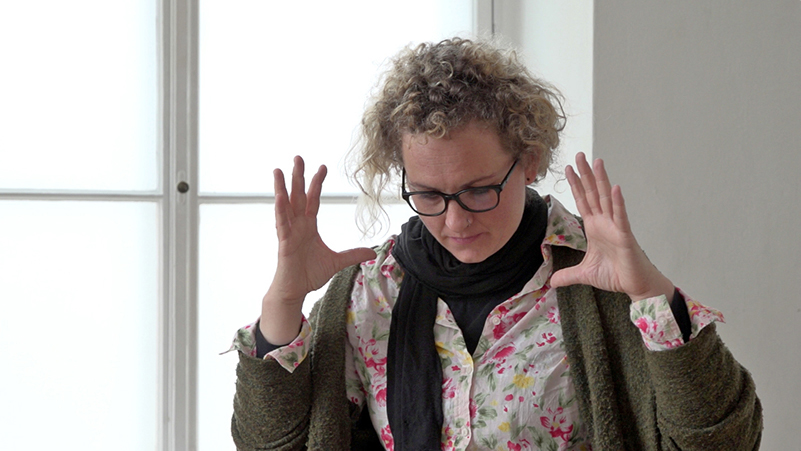
Synopsis: What happens if a philosophical text is mirrored in the world of sign language? What happens if thoughts and signs are translated into moving pictures? "Reading Through the Body" is a short ethnographic documentary showing how a woman who is deaf tries to comprehend and embody a text by Friedrich Nietzsche in an experimental setting.
"An accomplished sign language interpreter attempting the impossible becomes a mesmerising piece of performance art, in a film which reminds us that words are not necessary for a profound cinematic experience." FilmBath Festival, UK
Title: Reading Through the Body
Original Title: Körpersprache
Completion Date: May, 2016
Country of Origin: Austria
Author and Director: Mersolis Schöne
Reader and Performer: Lena Schramek
Camera, Cut, Sound Design: Christan Venosa
Assistant Director, Support, Camera Assistant: Emanuel Megersa
Production Assistant, Interviewer: Ronja Thum
Interpreter for Austrian Sign Language: Hanna Boesch
Film Type: Documentary, Short
Film Language: German / English
Original Format: HD, DCP
Running Time: 7 minutes 42 seconds
Special Thanks: Ethnocineca Vienna
Presented by: Moving Thought
Trailer:
Vimeo
Poster and Stills:
Flickr,
html,
folder, and
zip-file
IMDb:
IMDb
Streaming: Alexander Street Press
"Reading Through the Body" © Copyright 2016 MOVING THOUGHT
THINKING WITH THE HANDS
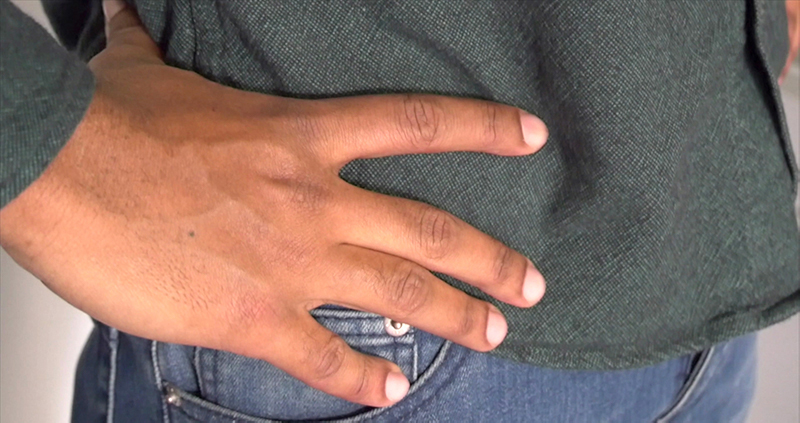
Synopsis: What role does physicality play in science? "Thinking with the Hands" is a short ethnographic documentary dedicated to the involvement of physicality in scientific knowledge production. We almost invariably picture knowledge generation as an eminently cerebral, cognitive work process where the body is all but irrelevant. In contrast, this film investigates the role played by hands in daily laboratory work routine.
Title: Thinking with the Hands
Original Title: Das denkende Tun der Hände
Completion Date: May, 2015
Country of Origin: Austria
Direction: Mersolis Schöne
Assistant Director: Laurentiu Constantin, Tim Seck
Film Type: Documentary, Short
Film Language: German / English
Original Format: 4K, DCP
Running Time: 9 minutes 28 seconds
Special Thanks: Ethnocineca Vienna
Presented by: Moving Thought
Trailer:
Vimeo
Poster and Stills:
Flickr,
html,
folder, and
zip-file
IMDb:
IMDb
"Thinking with the Hands" © Copyright 2015 MOVING THOUGHT
SCIENCE AND LOVE
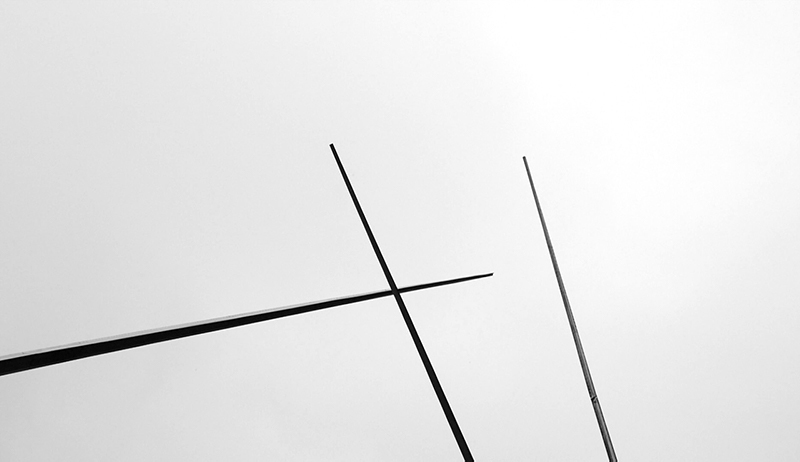
Synopsis: Bridging the gap between science and love, this film essay takes viewers on a journey of discovery through the public spaces of the University of Vienna to explore the connection between reason and emotion - between science and love. Within this philosophical experiment, contrasting images arise: a monument to rationality and a beating heart; a love letter and a technical definition of love.
Title: Science and Love
Original Title: Wissenschaft und Liebe
Completion Date: October, 2014
Country of Origin: Austria
Direction: Mersolis Schöne
Voices: Linda Erker, Jürgen Stowasser
Film Type: Philosophical Film Essay
Film Language: German / English
Original Format: 4K, DCP
Running Time: 9 minutes 39 seconds
Special Thanks: Herbert Posch
Presented by: Moving Thought
Trailer:
Vimeo
Poster and Stills:
Flickr,
html,
folder, and
zip-file
IMDb:
IMDb
"Science and Love" © Copyright 2014 MOVING THOUGHT
